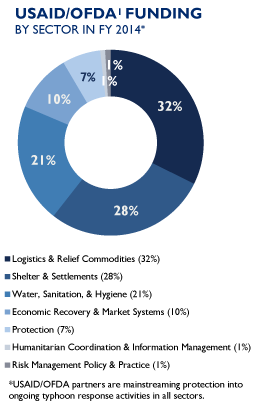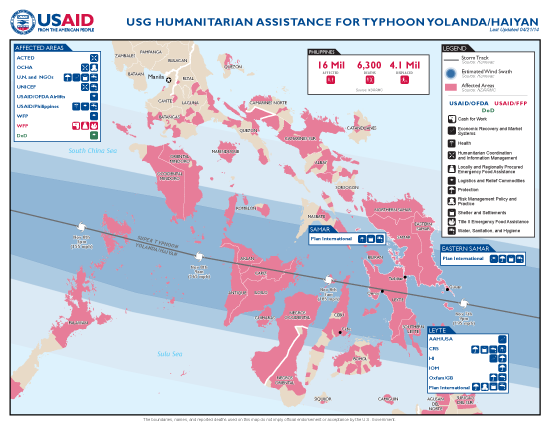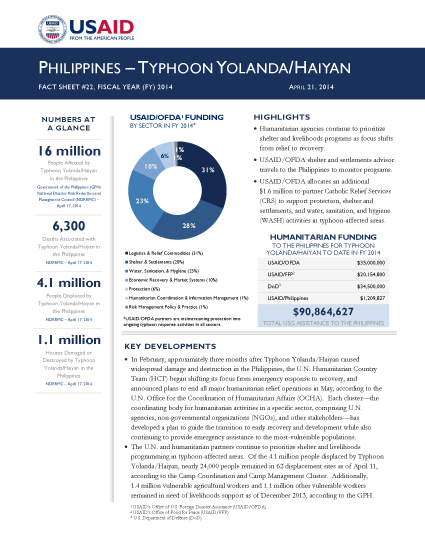- What We Do
- Agriculture and Food Security
- Democracy, Human Rights and Governance
- Economic Growth and Trade
- Education
- Ending Extreme Poverty
- Environment and Global Climate Change
- Gender Equality and Women's Empowerment
- Global Health
- Water and Sanitation
- Working in Crises and Conflict
- Disaster Assistance
- Political Transition Initiatives
- Conflict Mitigation and Prevention
- Countering Violent Extremism
- Disaster Risk Reduction
- Peacebuilding and Reconciliation
- Providing Safe & Secure Environments for Development
- Recovering From Crisis
- Resilience
- Tech Challenge for Atrocity Prevention
- World Humanitarian Day
- U.S. Global Development Lab
April 21, 2014
Philippines Typhoon Yolanda Program Map - 04-21-2014 ![]() (pdf - 898k)
(pdf - 898k)
Numbers At A Glance
16 million
6,300
4.1 million
1.1 million
Humanitarian Funding:
To The Philippines For Typhoon Haiyan/Yolanda To Date In FY2014:

| USAID/OFDA | $35,000,000 |
| USAID/FFP | $20,154,800 |
| DoD | $34,500,000 |
| USAID/Philippines | $1,209,827 |
| TOTAL | $90,864,627 |
Highlights
Humanitarian agencies continue to prioritize shelter and livelihoods programs as focus shifts from relief to recovery.
USAID/OFDA shelter and settlements advisor travels to the Philippines to monitor programs.
USAID/OFDA allocates an additional $1.6 million to partner Catholic Relief Services (CRS) to support protection, shelter and settlements, and water, sanitation, and hygiene (WASH) activities in typhoon-affected areas.
Key Developments
In February, approximately three months after Typhoon Yolanda/Haiyan caused widespread damage and destruction in the Philippines, the U.N. Humanitarian Country Team (HCT) began shifting its focus from emergency response to recovery, and announced plans to end all major humanitarian relief operations in May, according to the U.N. Office for the Coordination of Humanitarian Affairs (OCHA). Each cluster—the coordinating body for humanitarian activities in a specific sector, comprising U.N. agencies, non-governmental organizations (NGOs), and other stakeholders—has developed a plan to guide the transition to early recovery and development while also continuing to provide emergency assistance to the most-vulnerable populations.
The U.N. and humanitarian partners continue to prioritize shelter and livelihoods programming in typhoon-affected areas. Of the 4.1 million people displaced by Typhoon Yolanda/Haiyan, nearly 24,000 people remained in 62 displacement sites as of April 11, according to the Camp Coordination and Camp Management Cluster. Additionally, 1.4 million vulnerable agricultural workers and 1.1 million other vulnerable workers remained in need of livelihoods support as of December 2013, according to the GPH.
SHELTER AND SETTLEMENTS
Typhoon Yolanda/Haiyan damaged or destroyed nearly 1.1 million houses in the Philippines and displaced approximately 4.1 million people, according to the GPH. After initially focusing on providing life-saving emergency shelter assistance to typhoon-affected populations, Shelter Cluster priorities have begun to shift toward self-recovery support. As of April 11, Shelter Cluster partners had provided more than 560,000 households—or approximately 2.5 million people—with tents, plastic sheeting, mats, blankets, and cooking sets. Partners also provided approximately 107,000 households—or 556,000 people—with tools, construction materials, and technical guidance to repair their own homes.
The Shelter Cluster reports that typhoon-affected populations in the Philippines continue to face a shelter crisis, with more than 2 million people lacking access to durable shelter, partly due to households rebuilding without adequate construction knowledge or quality materials. Humanitarian partners have expressed concern that the already fragile humanitarian situation will further deteriorate in the coming months as typhoon season begins, typically in June.
After consultations with the Shelter Cluster and other humanitarian agencies, the GPH has revised its proposed plan to implement a blanket 40-meter no-build zone in coastal areas and has authorized local governments to determine building policies based on all-hazards risk mapping, according to the Shelter Cluster. However, until the new process is formalized through local and national authorities and hazard maps are developed, people currently residing in previously identified no-build zones remain vulnerable to future relocation, with limited knowledge of where they may eventually live or whether they will have access to their livelihoods.
The shelter sector remains underfunded, despite being identified as one of the most pressing post-typhoon needs. As of April 21, the Shelter Cluster had received nearly $64.8 million—or 33 percent—of the $178.4 million requested in the one-year U.N. Strategic Response Plan (SRP) for Typhoon Yolanda/Haiyan.
USAID/OFDA has provided more than $9.6 million in FY 2014 funding to support shelter and settlements activities in most-affected Eastern Samar, Leyte, and Samar provinces. A USAID/OFDA shelter and settlements advisor traveled to the Philippines in late March to monitor the implementation of USAID/OFDA-funded emergency and transitional shelter and settlements programs and assess ongoing shelter and settlements needs. The advisor met with implementing partners to review projects and discussed program activities with beneficiaries, cluster lead agencies, local and national government officials, and USAID/Philippines staff. The advisor reported that USAID/OFDA-funded emergency shelter and settlements activities have assisted approximately 30,000 households to date. In addition, partners have completed site assessments and beneficiary identification for USAID/OFDA-funded transitional shelter and settlements activities to assist more than 4,000 households in Tacloban city, Leyte Province. USAID/OFDA will continue to monitor overall shelter sector needs in addition to monitoring USAID/OFDA-funded project activities.
LIVELIHOODS
An estimated 5.9 million workers lost income sources due to Typhoon Yolanda/Haiyan, primarily as a result of infrastructure damage, lack of market access, and disrupted cash flow, according to the Early Recovery and Livelihoods Cluster. As of January 31, approximately 413,000 people had received livelihoods support in the form of cash assistance, according to OCHA. However, as the typhoon response shifts from emergency response to early recovery, relief agencies are transitioning from unconditional cash assistance programs to cash-for-work (CFW) and cash-for-training activities.
To provide livelihoods assistance while also promoting community-wide recovery, Early Recovery and Livelihoods Cluster partners are prioritizing emergency employment programs, such as CFW, that include debris-clearing and waste management activities, as well as the repair and reconstruction of public infrastructure, including hospitals and schools. In addition, cluster partners are offering skills training, as well as micro-enterprise and small business support, to the most-vulnerable populations. As of April 11, nearly 118,000 people in the Philippine’s Central Visayas, Eastern Visayas, MIMAROPA, and Western Visayas regions had received short-term employment and livelihood support and services, according to cluster partners. Results of the short-term employment programs include the repair of nearly 1,500 kilometers (km) of roads and more than 1,100 km of drainage canals, as well as the restoration of services in approximately 560 schools, 220 rural health care centers, and more than 30 hospitals.
Although livelihoods programs have shown success, the U.N. reports that early recovery and livelihoods activities remain underfunded. As of April 21, the Early Recovery and Livelihoods Cluster had received approximately $31.9 million—or 27 percent—of the $117.1 million requested in the Typhoon Yolanda/Haiyan SRP. Ongoing challenges include ensuring minimum wages and social protection benefits for emergency employment participants; collecting labor market information regarding the supply of and demand for skilled workers during the recovery phase to determine the skills training required in each region; and planning recovery strategies in coordination with local government authorities with limited disaster mitigation and management capacity.
In FY 2014, USAID/OFDA has provided nearly $3.3 million to support economic recovery and market systems (ERMS) programming to help severely affected communities in Leyte Province. With USAID/OFDA support, partners are implementing cash-based interventions to rehabilitate the fishing industry, targeting 2,500 fishing households, and providing cash grants or livelihoods kits to vulnerable populations.
HEALTH
The GPH Department of Health (DoH) reports that Typhoon Yolanda/Haiyan caused approximately $16 million in damage to 571 health facilities in typhoon-affected areas. The DoH, the U.N. World Health Organization (WHO), and other health partners continue to provide technical and material resources to support the provision of health care services, while also assessing the typhoon’s overall impact on the health sector and prioritizing health sector needs.
To improve the resilience of health facilities and the health care system to future disasters, the GPH is focusing its recovery efforts on developing integrated services and universal health coverage, ensuring the availability of a health workforce and essential medicines, particularly in remote areas. The Health Cluster is supporting the GPH by creating information and assessment materials on the most-damaged facilities and developing a website to share information on the status of health facilities and reconstruction activities. Cluster partners are also working to strengthen disease surveillance systems, as well as to prevent and respond to disease outbreaks.
The U.N. Children’s Fund (UNICEF), WHO, and their partners recently supplied cold chain equipment in Tacloban as part of their efforts to ensure the appropriate storage of vaccines used during routine immunizations and disease outbreaks. UNICEF provided solar-powered refrigerators to 50 health centers in typhoon-affected areas, as well as a back-up generator for the region. In addition, UNICEF has deployed supplies to field locations and trained health workers to improve management of the cold chain, increasing the number of routine vaccinations received and the resilience of the cold chain system.
As of April 21, donors had provided approximately $47.6 million—or 60 percent—of the $79.4 million requested by the Health Cluster in the Typhoon Yolanda/Haiyan SRP. Cluster partners report significant funding gaps for the rehabilitation of health facilities, which will negatively impact the continuity of health services if not addressed quickly.
WATER, SANITATION, AND HYGIENE
Like other sectors, the WASH Cluster is transitioning from immediate life-saving assistance to longer-term recovery and rehabilitation activities. As of April 11, WASH Cluster partners reported completing the distribution of more than 466,000 hygiene kits and 329,000 water treatment kits to typhoon-affected populations during the emergency relief phase of the response. Partners have ceased distributions in most areas but continue to provide both hygiene and water treatment kits in western Leyte Province, where many affected communities remained unreached until recently.
Repairs to water supply systems are ongoing in 11 municipalities in Eastern Samar Province and 23 municipalities in Leyte Province, according to the WASH Cluster. As of April 11, water supply infrastructure improvements had benefitted more than 412,000 people across the two provinces. Cluster partners have also begun scaling up the repair and construction of household sanitation facilities, providing access to sanitation facilities to more than 19,500 people in Eastern Samar and more than 145,000 people in Leyte, including households without access to adequate sanitation facilities before Typhoon Yolanda/Haiyan struck. Cluster partners plan to conduct a detailed WASH survey in the coming months across 80 affected municipalities to identify any remaining assistance gaps.
As of April 21, donors had provided approximately $61.5 million—or 76 percent—of the $81 million requested by the WASH Cluster in the Typhoon Yolanda/Haiyan SRP. Cluster partners remain concerned about the sanitation situation of people residing in transitional shelters, including GPH-built bunkhouses, as well as the ability of the WASH Cluster to support households relocated to permanent sites.
To date, USAID/OFDA has provided more than $7.8 million to support WASH activities in response to Typhoon Yolanda/Haiyan. Immediately following the typhoon, USAID/OFDA helped restore Tacloban city’s municipal water system by supporting the procurement of a generator, benefiting more than 250,000 people. USAID/OFDA partners have also distributed point-of-use water treatment solutions, installed mobile water treatment units, established communal water points, and conducted other activities to improve access to safe drinking water, in addition to working to restore access to sanitation facilities and conducting hygiene promotion interventions.
AGRICULTURE AND FOOD SECURITY
The Food Security and Agriculture Cluster (FSAC) reports that an estimated 5.6 million people remain in need of food assistance and support in typhoon-affected areas to prevent food insecurity and restore agricultural and fishing livelihoods. As of April 11, FSAC partners reported reaching approximately 4.6 million people with food assistance, with 3.2 million receiving food distributions and the remainder receiving cash transfers. Partners also reported that more than 80,000 farmers benefitted from seed distributions from the GPH and FSAC.
As of March 6, the U.N. World Food Program (WFP) had dispatched a total of 33,350 metric tons (MT) of food to typhoon-affected areas, including approximately 32,600 MT of rice, 170 MT of specialized nutrition products, and 560 MT of high-energy biscuits (HEBs). WFP is currently scaling down many of the programs implemented in response to Typhoon Yolanda/Haiyan, although it plans to continue providing targeted food distributions to 60,000 beneficiaries located primarily in isolated communities in mountainous areas and on remote islands. WFP has provided 150,000 beneficiaries with nutrition assistance and has now transitioned the assistance to a targeted supplementary feeding program and the provision of micro-nutrient powders. WFP is also targeting approximately 40,000 households with cash-for-assets and food-for-assets programs, primarily in Eastern Samar Province and Western Visayas Region’s Aklan Province.
USAID/FFP remains the largest contributor of food assistance to WFP's emergency operation to date, providing more than $20 million in food assistance to the Philippines since WFP's emergency operation began in November 2013. USAID/FFP support has included more than 6,000 MT of U.S.-sourced rice and 55 MT of U.S.-sourced emergency food products, including nutritional pastes and rice and wheat bars, valued at more than $8.6 million. In addition, USAID/FFP contributed nearly $11.5 million for the local purchase of 2,400 MT of rice and 40 MT of supplemental HEBs, as well as support for cash-based programming, including CFW, cash-for-assets, and cash transfer activities to help affected families purchase food in local markets. Through its contributions, USAID/FFP has provided critical food assistance reaching more than 3 million typhoon-affected people.
As of April 21, donors had provided approximately $121 million—or 65 percent—of the $185 million requested by FSAC in the Typhoon Yolanda/Haiyan SRP. FSAC partners report that major gaps in funding for livelihoods activities continue to hamper recovery, particularly for small-scale coconut farmers, many of whom were among the poorest residents of the Philippines before the typhoon and were also among the most severely affected.
PROTECTION
The Protection Cluster continues to monitor and respond to the needs of vulnerable groups in typhoon-affected areas, including women, children, indigenous populations, the elderly, and the disabled. Cluster partners are operating in 119 municipalities and working closely with the GPH to identify assistance gaps and address ongoing challenges.
As of April 11, the Child Protection Working Group had reached nearly 69,000 children with psychosocial support through 192 child-friendly spaces in typhoon-affected areas. Protection Cluster partners had provided training on psychosocial first aid and psychosocial support techniques to a total of 670 people, including GPH officials, community members, and NGO staff. Partners had also conducted four trainings on the clinical management of rape, benefiting more than 110 health care professionals in Eastern Samar, Iloilo, Leyte, and Roxas provinces and developed 22 women-friendly spaces in Eastern and Western Visayas regions.
The Office of the U.N. High Commissioner for Refugees (UNHCR), in collaboration with the GPH, recently launched a free mobile registration project in Leyte and Eastern Samar provinces to replace civil documents, such as birth and marriage certificates, lost or destroyed as a result of Typhoon Yolanda/Haiyan. The project aims to help 100,000 people re-establish their civil identities, which will enable them access to state welfare programs, education, and employment opportunities. The program will also provide documents to residents who did not have official documents before the typhoon struck. The GPH anticipates that the program will be fully implemented in June.
The Protection Cluster had received approximately $21.7 million—or 49 percent—of the $44.7 million requested in the SRP for Typhoon Yolanda/Haiyan as of April 21. Cluster partners have indicated that geographical coverage of gender-based violence prevention and response activities remains limited due to a lack of funding. In addition, partners have expressed the need for additional information management capacity to collect and analyze data as the humanitarian focus shifts from relief to early recovery.
USAID/OFDA has provided more than $2 million in FY 2014 to directly support protection activities, including educating communities on protection-related issues, replacing critical documents, tracking displacement and population movements, and providing technical support to integrate protection issues into other humanitarian assistance activities.
INTERNATIONAL ASSISTANCE
As of April 21, international donors had provided approximately $796 million—both inside and outside the appeal—to address the needs of populations affected by Typhoon Yolanda/Haiyan. Of the total, approximately $432 million supports projects in SRP, representing nearly 55 percent of the appeal.









Comment
Make a general inquiry or suggest an improvement.